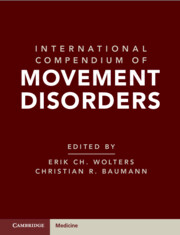Book contents
- International Compendium of Movement Disorders
- International Compendium of Movement Disorders
- Copyright page
- Contents
- Contributors
- International Compendium of Movement Disorders
- Hypo- and Hyperkinetic, Dyscoordinative and Otherwise Inappropriate Motor and Behavioral Movement Disorders
- Section 1: Basic Introduction
- Section 2: Hypokinetic Movement Disorders
- Chapter 12 Autonomic Dysfunction in Parkinson’s Disease
- Chapter 13 Neuropsychiatric Manifestations in Parkinson Disease
- Chapter 14 Sleep–Wake Disorders in Parkinson’s Disease
- Chapter 15 Neuronal Activity in the Basal Ganglia and Thalamus in Patients with Parkinson’s Disease
- Chapter 16 Pathology in Parkinson’s Disease
- Chapter 17 Diagnosis of Parkinson’s Disease
- Chapter 18 Prodromal Manifestations of Parkinson’s Disease
- Chapter 19 Biomarkers in Parkinson’s Disease
- Chapter 20 Physical Rehabilitation of Patients with Parkinson’s Disease
- Chapter 21 Regenerative Strategies for Parkinson’s Disease
- Chapter 22 Conventional Pharmacotherapy in Parkinson’s Disease
- Chapter 23 Continuous Dopaminergic Stimulation in Parkinson’s Disease
- Chapter 24 Pipeline of Pharmacotherapy in Parkinson’s Disease
- Chapter 25 Non-Invasive Brain Stimulation for the Treatment of Parkinson’s Disease
- Chapter 26 Deep Brain Stimulation in Parkinson’s Disease
- Chapter 27 Focused Ultrasound in Parkinson’s Disease
- Chapter 28 Dementia with Lewy Bodies
- Chapter 29 Genetic Parkinsonisms
- Chapter 30 Multiple System Atrophy
- Chapter 31 Progressive Supranuclear Palsy
- Chapter 32 Corticobasal Degeneration and Corticobasal Syndrome
- Chapter 33 Other Tau-Related Parkinsonisms
- Chapter 34 Vascular Parkinsonism
- Chapter 35 Illicit Drug–Induced Parkinsonism
- Section 3: Hyperkinetic Movement Disorders
- Section 4: Dyscoordinative and Otherwise Inappropriate Motor Behaviors
- Section 5: Objectifying Movement Disorders
- Movement Disorders in Vivo: Video Fragments
- Acronyms and Abbreviations
- Index
- References
Chapter 21 - Regenerative Strategies for Parkinson’s Disease
from Section 2: - Hypokinetic Movement Disorders
Published online by Cambridge University Press: 07 January 2025
- International Compendium of Movement Disorders
- International Compendium of Movement Disorders
- Copyright page
- Contents
- Contributors
- International Compendium of Movement Disorders
- Hypo- and Hyperkinetic, Dyscoordinative and Otherwise Inappropriate Motor and Behavioral Movement Disorders
- Section 1: Basic Introduction
- Section 2: Hypokinetic Movement Disorders
- Chapter 12 Autonomic Dysfunction in Parkinson’s Disease
- Chapter 13 Neuropsychiatric Manifestations in Parkinson Disease
- Chapter 14 Sleep–Wake Disorders in Parkinson’s Disease
- Chapter 15 Neuronal Activity in the Basal Ganglia and Thalamus in Patients with Parkinson’s Disease
- Chapter 16 Pathology in Parkinson’s Disease
- Chapter 17 Diagnosis of Parkinson’s Disease
- Chapter 18 Prodromal Manifestations of Parkinson’s Disease
- Chapter 19 Biomarkers in Parkinson’s Disease
- Chapter 20 Physical Rehabilitation of Patients with Parkinson’s Disease
- Chapter 21 Regenerative Strategies for Parkinson’s Disease
- Chapter 22 Conventional Pharmacotherapy in Parkinson’s Disease
- Chapter 23 Continuous Dopaminergic Stimulation in Parkinson’s Disease
- Chapter 24 Pipeline of Pharmacotherapy in Parkinson’s Disease
- Chapter 25 Non-Invasive Brain Stimulation for the Treatment of Parkinson’s Disease
- Chapter 26 Deep Brain Stimulation in Parkinson’s Disease
- Chapter 27 Focused Ultrasound in Parkinson’s Disease
- Chapter 28 Dementia with Lewy Bodies
- Chapter 29 Genetic Parkinsonisms
- Chapter 30 Multiple System Atrophy
- Chapter 31 Progressive Supranuclear Palsy
- Chapter 32 Corticobasal Degeneration and Corticobasal Syndrome
- Chapter 33 Other Tau-Related Parkinsonisms
- Chapter 34 Vascular Parkinsonism
- Chapter 35 Illicit Drug–Induced Parkinsonism
- Section 3: Hyperkinetic Movement Disorders
- Section 4: Dyscoordinative and Otherwise Inappropriate Motor Behaviors
- Section 5: Objectifying Movement Disorders
- Movement Disorders in Vivo: Video Fragments
- Acronyms and Abbreviations
- Index
- References
Summary
In Parkinson’s disease, parkinsonism occurs due to the loss of dopaminergic neurons of the substantia nigra. Existing treatments can enhance dopaminergic activity in the brain, but cause adverse effects due to the non-targeted, non-physiologic dopamine delivery, so there is interest in developing regenerative therapies to restore dopaminergic tone in the striatum in a targeted, physiologic manner. Experimental approaches include using viral vectors to deliver genes encoding growth factors or enzymes involved in dopamine synthesis, or to target nucleic acids and gene expression. A number of cell types have been considered potential sources of cell-based therapies for PD and have been trialled in humans and animals, but all have been limited by either poor efficacy, poor graft survival, or logistical barriers. However, stem cells offer a renewable source of dopaminergic cells and hold great promise as potential regenerative treatments, and human trials have begun. Although these treatments remain experimental, some are entering clinical trials and there is hope that they will become available for clinical use in the future.
Keywords
- Type
- Chapter
- Information
- International Compendium of Movement Disorders , pp. 252 - 263Publisher: Cambridge University PressPrint publication year: 2025

